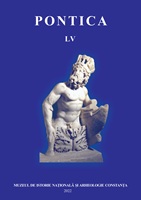Ceramică medieval-timpurie din Dobrogea. Restituiri
Early medieval ceramics from Dobruja. Restorations
Author(s): Cristina Paraschiv-TalmațchiSubject(s): Archaeology, Archiving, Preservation, 6th to 12th Centuries
Published by: Muzeul de Istorie Națională și Arheologie Constanța
Keywords: settlement; ceramic; pitcher; glazed; 8th-10th centuries; south-east Romania,
Summary/Abstract: The objective of the article is to complete the Dobrujan archeological repertoire by putting in the scientific circuit some older data referring to the early medieval period, which have not been published until now. In this regard, two topics will be addressed: the results of preventive research in the settlement of Șiriu (Constanța county) and the presentation of six ceramic vessels in the collection of the Museum of National History and Archeology in Constanța. The short exposition of the settlement from Șiriu is based on information provided by PhD. Constantin Chera, the one who carried out, in 1979, the preventive research, on the occasion of the construction of an irrigation pipeline. At that time, five deep dwellings (deepened huts) were registered, all with a clay floor and a fire pit built of unshaped stones, except for one with a hollowed-out oven in the wall. The pottery represented the majority of the material discovered, including a whole vessel for storing supplies, with a height of 0.50 m. Based on known data, we consider that the settlement belongs to the 9th century and the first decades of the 10th century. The six vessels were discovered in Medgidia or on the territory of Constanța County. They are all jugs. Of these, three were modeled from common, fine paste, and were burned in a reducing atmosphere, one from common paste and was oxidized, and two from kaolinoid paste, also oxidized. In particular, two draw our attention: a pitcher with three handles covered with olive-green glazed and a jug of fine paste, which has conical prominences applied on the neck. The way of decorating one of the jugs made of kaolinoid paste is also unusual. Broadly, the jugs presented belong to the 8th-10th centuries, for each vessel being offered a restricted dating according to the general characteristics and known analogies.
Journal: Pontica
- Issue Year: 2022
- Issue No: 55
- Page Range: 353-370
- Page Count: 18
- Language: Romanian

